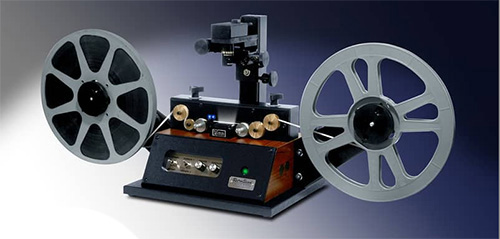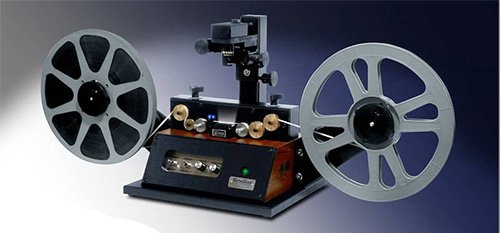
I’ve been using the RetroScan Universal for scanning 8mm, Super 8 and 16mm films since May of 2018. I’ve been very happy with the results. This machine works differently from all the others I have used or studied. It scans frame-by-frame high definition stills and can handle any sized film reel. What sets this machine apart is that there are no claws, sprocket advancers or pinch rollers. There is an open gate so you can crop however you like. You can crop the entire frame like they did with the Zapruder Film. That’s the most famous 8mm film ever shot. It recorded the assassination of President John F. Kennedy at Dealey Plaza in Dallas, Texas, on November 22, 1963. That film transfer shows the sprocket holes and other hidden parts of the scene that are typically cropped out of 8mm transfers.
Most telecines or film scanners require claws or other hardware to move the film one frame at a time. The consumer Wolverine Machines I had been using had claws. And they work fine when the film is in perfect shape. But no films that are 40 – 60 years old are in perfect shape. Chances are they have been projected so many times that some or many sprockets have been torn. Torn sprockets and similar defects cause problems with machines like the Wolverine. This means with a damaged film you have to babysit the scan. And at 2 frames per second this can be tedious.
What’s Different About the RetroScan Universal
The RetroScan Universal works differently by pulling the film through the film path. In the center of the film path there is an LED illuminator. Directly above there is a high speed digital camera (HD or 2K) that takes still pictures of each illuminated frame. The film is pulled through at about 15 frames per second. The software identifies the precise frame by lining up the sprocket holes, but this is an optical rather than a mechanical registration. The result is rock steady registration, better than any other I’ve seen. Projectors and scanners that require a claw are subject to wear which erodes the registration. The registration of this machine will not change.
Normal projectors and telecines have an intermittent film movement. This means that the film starts and stops for each frame of film. Starting and stopping requires an advance claw. Because the Universal has no advance claw, damaged sprocket holes will just slide through the system. The film moves through the unit continuously and never stops for each frame. The high speed camera freezes every frame. Instead of capturing to a video codec, the software captures to a proprietary progressive still frame format. The software also has RGB color controls and a brightness/gamma adjustment which you can adjust on the fly.
Creating A Video Codec
When you finish scanning a reel, you can look at the video at various frame rates to see which is most accurate. You might think you would do this before scanning, but both the frames per second rate and the format (4:3, HD, etc) are chosen after you scan. That’s because even though you can see this as a movie, it is a large collection of stills that need to be converted into a movie file. The software allows you to watch the stills as a movie, but you can’t do anything else with them. To make a video file you can actually use, you have to export the stills to a video format like Quicktime or AVI.
After the export, you can bring these files into your NLE. Since the RetroScan Universal has no claw, there are very few times the scan will stop unless you need to make a big exposure change or something like that. So I am doing a lot less editing than I had to do with the Wolverine machines. With those machines I’d have to cut out the blanks spots anytime the machine stopped. In fairness, Wolverine says their machines are not intended for commercial use.
Since the RetroScan Universal works unlike any machine you have used, reading the instructions is not optional. But the support is excellent. I’ve called Roger, the owner, quite a few times and each time he has patiently explained to me what I was doing wrong and how to Fix it. I would say learning this machine is easier than learning your first Non-Linear Editing system, but you will have to read the instructions and do your home work.
The export function is slow. It can take overnight if you have a lot of reels, but knowing this in advance makes it easy to plan. My biggest job on this machine so far has probably been 8 seven inch 16mm reels. They were exported while I did other things. So far I have not had an overnight export.
The RetroScan Universal software can export in PAL or NTSC, as standard definition or high definition. It can capture color negative. There is also an optional gate which can handle slides, but only one at a time. The Pacific Image Automated 35mm Slide Scanner machine I have does 50 slides unattended so that’s a much better value for a business.
All I need to do is set up the RetroScan and run a short preview test to make sure exposure, focus and framing are correct.
The machine is $5000 which includes the gate of your choice. Fortunately there’s a combined gate that does both 8mm and Super 8. I bought a 16mm gate for an extra $500. Changing the gate only takes a minute. The software is sold separately and is another $200. So this is an expensive package for doing film transfers. I spent a lot of time looking for cheaper alternatives. This is all documented in the new version of Start Your Own Video Transfer Business. An important factor in my decision is that all of the machines made by MovieStuff have a very good resale value.
RetroScan Universal will run on a Mac using a Windows emulator such as Bootcamp, Parallels, or others.
Bottom Line: I know I made the right decision in buying this machine. I’m sure it will pay for itself. It makes my work so much easier and it gives my customers a better product. Just about time to raise my prices for film transfers.
The RetroScan Universal units are all built to order so it takes about two months to get one. For more information, see Moviestuff.







I like your review but this scanner discontinue from Moviestuff and 816 model not in my budget and searching for used this type of scanner.
They make good scanners. I would suggest you also look for earlier models of their film scanners. Dig deeper. Don’t give up.